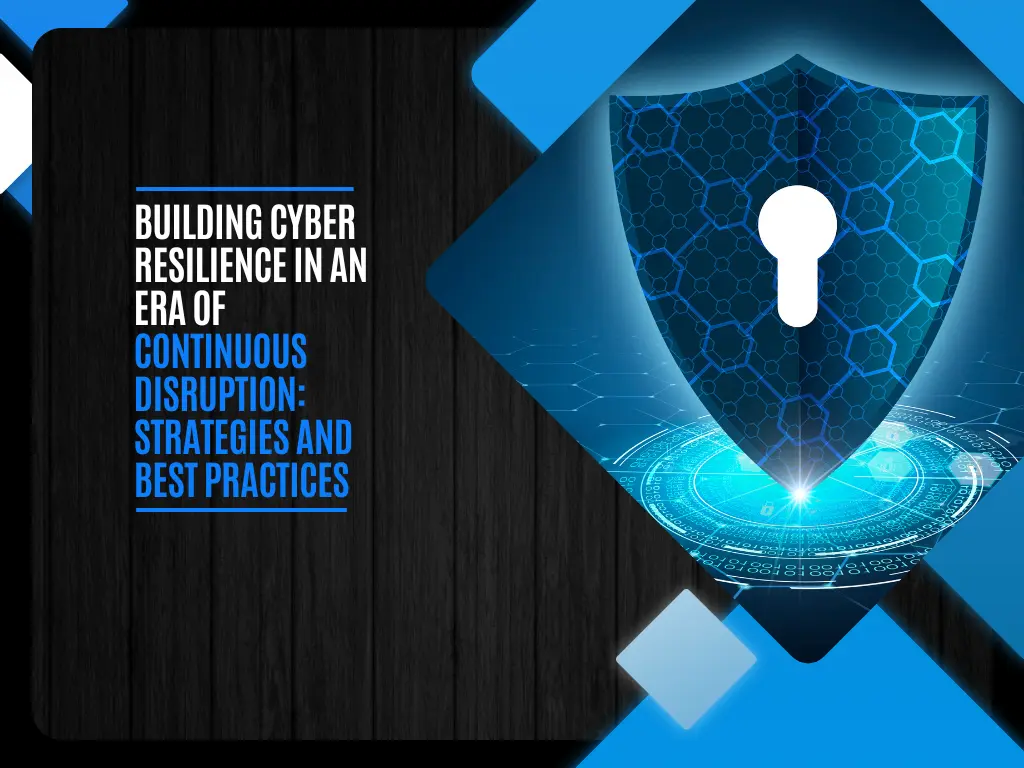Building Cyber Resilience in an Era of Continuous Disruption: Strategies and Best Practices
Discover strategies and best practices for building cyber resilience in an era of continuous disruption. Safeguard your digital assets.

The fast growth of cyber risks and online crimes has evolved cybersecurity from a basic IT requirement to a critical component of any organization’s strategic strategy. It is high time that enterprises should recognize the need for effective cybersecurity strategies to protect their operations and preserve consumer trust. Businesses are facing issues because of cyber threats. It may be related to the sophisticated attacks on large enterprises or the subtle breaches on firms of all sizes.
Cyberattacks have far-reaching consequences. This can include immediate financial losses, operational halts, huge legal fines, and whatnot. The worst is the long-term brand reputation damage.
Statista states that the global indicator ‘Estimated Cost of Cybercrime’ in cybersecurity is anticipated to climb by 5.7 trillion US dollars between 2023 and 2028. It features cyber resilience and is designed to protect businesses against cyber attacks. The same also helps strengthen operations by minimizing risks.
This blog will highlight the importance and complexities of developing a robust cyber resilience strategy.
Adaptive Security Frameworks to Navigate Cyber Threats
The motive behind developing the cybersecurity frameworks is to manage the dynamic and ever-changing threat landscape. In the phase of constant disturbances, traditional static techniques are no longer adequate. Over time, the emphasis has turned to adaptive frameworks that can quickly respond to evolving cyber threats.
80% of organizations said that security awareness training had reduced their staff’s susceptibility to phishing attacks; as per Usecure.
Key elements of an Adaptive Security Framework include:
- Continuous Monitoring: In adaptive security, vigilant real-time monitoring replaces standard periodic assessments for quick threat identification and response.
- Threat Intelligence: It gathers and utilizes knowledge on existing and upcoming cyber threats with the motive to strengthen defenses.
- Behavioral Analytics: Moreover, it establishes a behavioral baseline to detect irregularities in system activity and provide warnings for potential security risks.
- Automation and Orchestration: By automating regular processes, security teams can respond to increasingly sophisticated cyber attacks in minimum time.
- Well-defined incident response plans, which are an essential component of adaptive security, equip firms to efficiently contain, eliminate, and recover from security breaches.
Integrating AI and ML for Predictive Cyber Defense
Advanced technology is crucial to detect and respond to cyber attacks in real-time in 2024. These systems are meant to adapt themselves from experiences to stay up with the ever-changing world of cyber dangers. Here’s how:
- Real-time Threat Detection and Mitigation: Artificial Intelligence and Machine Learning algorithms play a major role to evaluate massive volumes of data in real-time. Plus, it also helps in discovering trends and abnormalities that can suggest possible cyber attacks. Statistically, businesses using AI for threat detection face a reduction in reaction time to cyber events by 30% – IBM.
- Autonomous Adaptation to Evolving Risks: AI and ML-powered intelligent systems are meant to learn from continuous cyber threats. They change their defensive methods independently to keep ahead of changing threats without requiring operator intervention.
Incident Response in Real-Time
When dealing with cybersecurity events, it’s all about being swift and agile. While automation and orchestration technologies enable a coordinated and timely resolution process, agile response methods reduce the impact of problems.
- Protocols for Agile Incident Response: In the event of a cybersecurity problem, quick and adaptable incident response strategies are put in place to minimize disruption. To address and resolve multiple types of security breaches in minimum time, these cybersecurity strategies explain the step-by-step methods to follow.
- Utilizing Automation and Orchestration: These technologies prove to be really helpful in improving and streamlining the incident response process. These solutions automate common operations and coordinate various security measures, allowing for a more rapid and coordinated response.
Securing the Cloud: Resilience in a Decentralized Infrastructure
Securing the Cloud entails putting in place robust security mechanisms to guard against many types of cyber attacks. It’s like erecting a fortress around the digital area where data is kept and processed, ensuring that it’s always accessible and reliable. It has the following features:
- Effective Cloud Security Measures: Putting robust security mechanisms in place to defend the Cloud from potential dangers. This involves the use of cutting-edge technology and protocols to secure the security, integrity, and availability of data stored on the Cloud.
- Data Availability and Integrity: In a dispersed and dynamic computer environment, ensuring that data remains unmodified and is constantly available. This is critical for ensuring the dependability of Cloud-hosted services.
Overall, the objective is to establish a durable and secure Cloud environment in which data is not only protected but also easily accessible.
Human-Centric Cybersecurity: Training and Empowering the Workforce
Businesses can gain an advantage in handling cybercrime. They can make sure that everyone in the organization knows and actively participates in keeping digital information secure. It’s similar to instructing everyone on a large team to be on the lookout for potential digital threats.
- Fostering a Cybersecurity-Aware Culture: It entails fostering a climate within enterprises where everyone values cybersecurity. This entails establishing in all workers a sense of responsibility and awareness about potential cyber dangers.
- Staff as Proactive Defenders: Giving staff the skills and information they need to actively protect against cyber attacks. This goes beyond basic knowledge and helps individuals to identify and respond to possible security threats ahead of time.
Cultivating a Culture of Cybersecurity Awareness
Many businesses may feel whether it is necessary for them to be concerned about cybercrime.
To answer the question, here is a look at how frequently cybercrime occurs. According to Astra data, 33 billion accounts were hacked in the last year alone (2023). This equates to an average of 2,328 breaches every day, with 97 new cybercrime victims every hour. These figures underscore the tenacity of cyber attacks, emphasizing the critical necessity for effective cybersecurity solutions.
Building and strengthening cyber resilience has emerged as a major need for enterprises seeking to protect their operations. Yes, it is essential, but the actual power resides in instilling cybersecurity awareness throughout the organization. This insight is further enriched by the findings of the State of Cybersecurity Report 2023, offering enterprises a strategic guide in fortifying operations, safeguarding against cyber threats, and ensuring a resilient and secure digital future.



